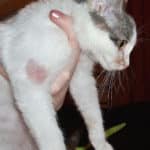Ringworm
Ringworm is the common name for a skin infection caused by one of several Dermatophyte fungi. The name is misleading as the infection has got nothing to do with worms. Ringworm fungi can cause infection in many types of animals, including people, cats and dogs. The disease tends to show as reddish, scaly rings on the skin of people. Some infected animals (especially young cats) may show no skin lesions at all and others will have patches of dry scaly skin or other types of skin change. Most lesions that look like the classic ringworm rings in animals are actually caused by Staphylococcus bacteria.
Ringworm can spread from animals to people, from people to animals and both can catch the infection from the soil. Fungal spores are shed from infected skin, where they can survive in the environment for months to years before causing infection. People and animals with a weaker immune system (they are young, old, sick or on certain medications) are at greater risk of developing a ringworm skin infection. Some animals are only diagnosed when a human member of the family develops a skin lesion.
Several different techniques can be used to try to diagnose a ringworm infection in animals. About 50% of the most common type of dermatophyte fungi will fluoresce under an ultraviolet light, so this is the easiest way to confirm an infection. If there is no fluorescence under a UV lamp, then other methods such as examination of a hair sample under the microscope (though the spores are very difficult to find) and fungal cultures (though this will often take 2 weeks) can be used to try to confirm the disease. In rare instances a skin biopsy may be the only way to diagnose the problem.




If you are suspicious that your pet may have ringworm (for example if members of the family started to get ringworm lesions after a new kitten was purchased, or your pet has unexplained skin lesions) then an appointment should be made for the pet to be examined by a vet. If the animal is diagnosed with ringworm, or sometimes if we are just strongly suspicious of ringworm, we can start a treatment plan to try to clear the infection and minimise the risk of further lesions in the pet and other family members. This treatment generally involves a dual approach, in that it is necessary to treat the affected pet or pets, as well as the household environment (because the spores can be so long-lasting). Oral medication is available, but as these medications inhibit fungal reproduction rather than directly killing the ringworm, the course will often need to last 1-2 months. Washing the pet in an antifungal shampoo (often twice weekly) helps to control the infection and reduce environmental contamination. The other part of the approach to dealing with a ringworm infection involves decontamination of the environment. Thorough frequent vacuuming of the carpets and areas that the animal spends time can reduce the contamination of the environment and reduce the risk of further problems. Steam-cleaning of the carpets, although not hot enough to kill spores, would help to reduce contamination even more than vacuuming. After solid surfaces have been cleaned, they can be disinfected (a 1:10 solution of bleach, left on for 10 minutes is effective, but this must only be used on surfaces that aren’t going to be damaged by the bleach).






